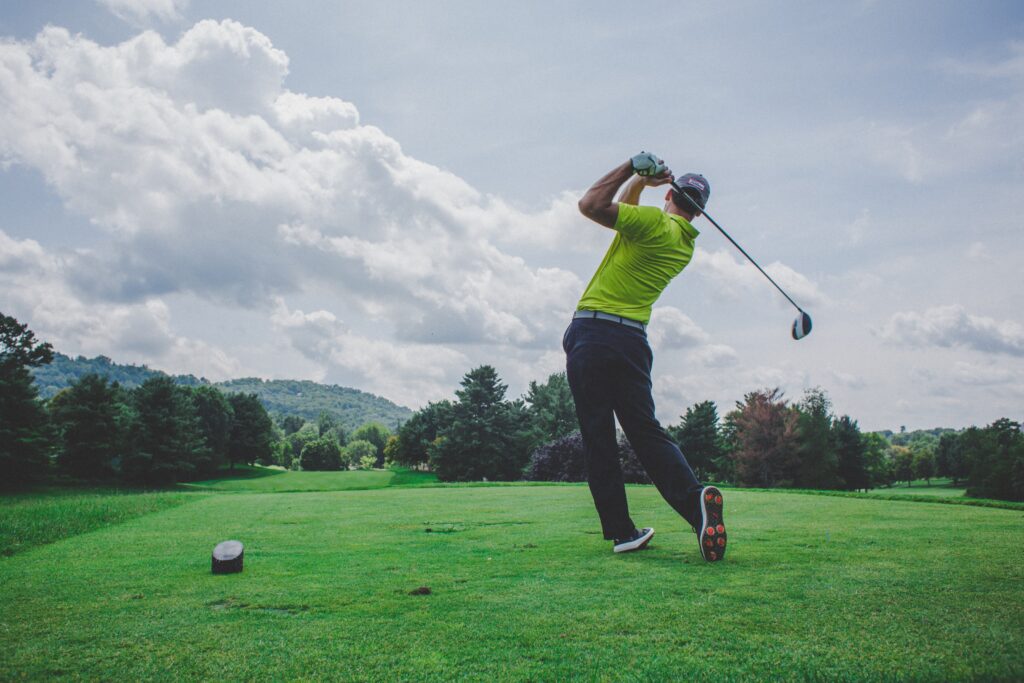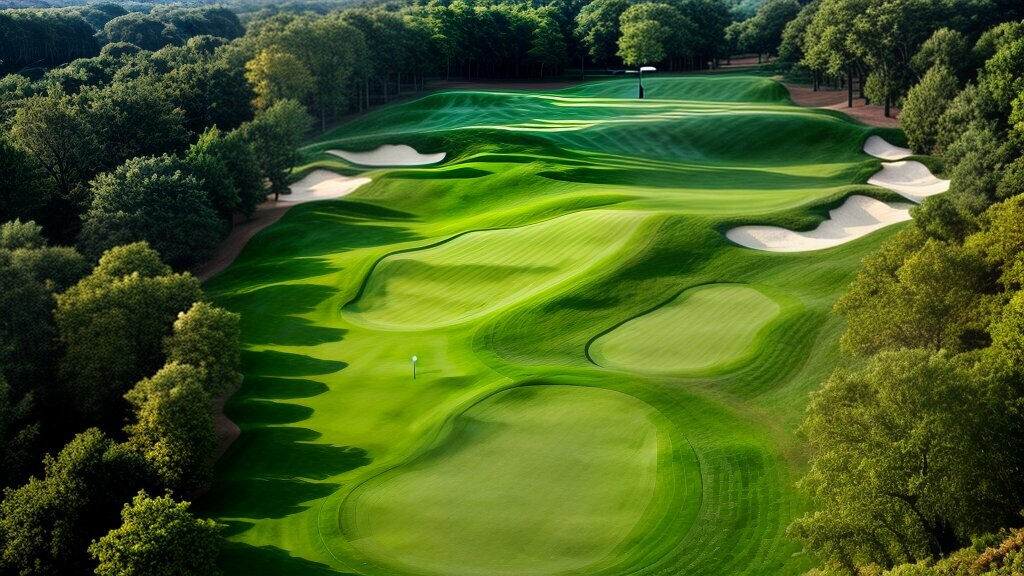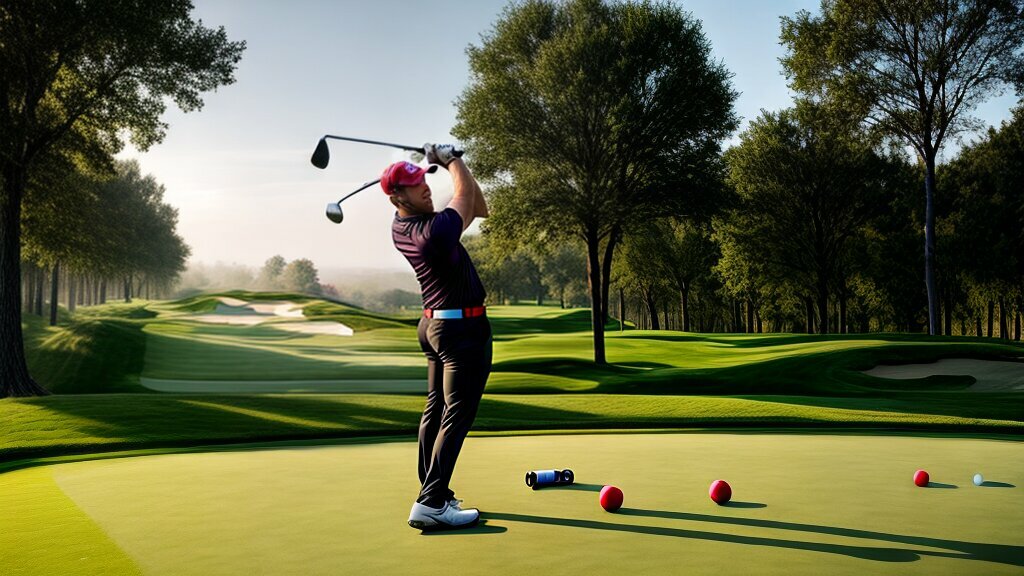Golf Shot Differences – Draw V. Fade
The video below focuses on the use of Trackman technology to analyze various data such as spin rate, launch angle, height, and landing angle, and how these differences can impact a player’s game on the golf course.
It emphasizes the importance of understanding these discrepancies and getting properly fitted for equipment based on individual swing characteristics. The video, presented by 2nd Swing Golf, seeks to provide valuable insights to golfers who are trying to decide whether to play a draw or a fade.

Understanding the Draw and Fade in Golf
Golf is a sport that requires precision and control. One of the skills that sets apart amateur golfers from the professionals is the ability to hit a draw or a fade. These shots are essential for navigating obstacles on the course and can greatly impact your overall score. Whether you are a beginner looking to improve your game or an experienced golfer striving for consistency, it is crucial to understand the differences between a draw and a fade.
What is a draw?
A draw is a golf shot that curves from right to left for a right-handed golfer (opposite for left-handed golfers). It is often considered a more desirable shot shape because it allows the golfer to generate more distance and control over the ball. When executed correctly, a draw shot starts slightly to the right of the target and curves back towards it. This shot shape can be particularly useful when navigating doglegs or when you need to carry the ball over a hazard.
What is a fade?
On the other hand, a fade is a shot that curves from left to right for a right-handed golfer (opposite for left-handed golfers). While it may not provide the same distance as a draw, a fade can be just as effective in certain situations. A fade shot starts slightly to the left of the target and moves gently towards the right. This shot shape is beneficial when you need to accurately control the ball’s trajectory or when you want to avoid obstacles on the course.
Importance of understanding the differences
Understanding the differences between a draw and a fade is crucial because it allows you to adapt your shot selection according to the course conditions and your desired outcome. By mastering both shot shapes, you can expand your repertoire and become a more versatile and effective golfer. Additionally, understanding the differences can help you diagnose any swing or clubface alignment issues that may be affecting your overall game.
Trackman Data and its Role in Differentiating Draw and Fade
To accurately analyze and differentiate between a draw and a fade, golf professionals and enthusiasts rely on advanced technology such as Trackman. Trackman is a radar-based system that provides precise measurements of various parameters during a golf swing. By understanding the data measured by Trackman, golfers can gain insights into their shot shapes and make necessary adjustments to improve their game.
Explaining Trackman technology in golf
Trackman uses Doppler radar to track the golf ball’s trajectory and provides detailed information about the swing and impact conditions. It can accurately measure parameters such as clubhead speed, launch angle, spin rate, and ball flight shape. This technology has revolutionized the way golf is played and taught, as it provides objective data that eliminates guesswork and allows for more precise analysis.
Data measured by Trackman
Trackman provides an extensive range of data that helps golfers analyze their shots and understand the differences between a draw and a fade. The key parameters that Trackman measures are spin rate, launch angle, height, landing angle, ball flight shape, and side spin. By examining these data points, golfers can gain insights into the factors that contribute to their shot shape and make necessary adjustments to achieve the desired ball flight.
How Trackman helps differentiate draw and fade
Using the data provided by Trackman, golfers can differentiate between a draw and a fade based on their shot patterns and tendencies. For example, a draw shot typically has a higher spin rate and a more pronounced curvature from right to left (for right-handed golfers). On the other hand, a fade shot often has a lower spin rate and a gentle curvature from left to right. By analyzing these data points, golfers can identify their preferred shot shape and work on refining their techniques.
Differences in Trackman Data between Draw and Fade
To gain a deeper understanding of the differences between a draw and a fade, let’s take a closer look at the specific Trackman data points that distinguish these shot shapes.
Spin rate
Spin rate refers to the amount of backspin or sidespin generated on the golf ball upon impact. Typically, a draw shot tends to have a higher spin rate compared to a fade. The increased spin helps the ball curve more dramatically from right to left (for right-handed golfers) in a draw shot. Conversely, a fade shot has a lower spin rate, resulting in a gentler left-to-right curvature.
Launch angle
Launch angle is the vertical angle at which the ball takes off after impact. In general, a draw shot has a slightly higher launch angle compared to a fade. The higher launch angle allows the ball to reach its apex more quickly and gives it more time to curve from right to left. A fade, on the other hand, has a slightly lower launch angle, resulting in a flatter trajectory and a more controlled right-to-left curvature.
Height
Height refers to the maximum height the ball reaches during its flight. A draw shot typically has a higher ball flight compared to a fade. The increased height allows the draw shot to carry more distance and provides the golfer with extra control over the ball’s trajectory. Conversely, a fade shot has a slightly lower ball flight, which can be advantageous when trying to keep the ball under tree branches or strong winds.
Landing angle
Landing angle is the angle at which the ball descends towards the target after reaching its apex. A draw shot tends to have a steeper landing angle compared to a fade. The steeper angle of descent allows the draw shot to stop more quickly upon landing, making it easier to control the distance on approach shots. A fade shot, on the other hand, has a shallower landing angle, which can be beneficial on firm and fast greens where the ball needs to release and roll out.
Ball flight shape
The most apparent difference between a draw and a fade is the curvature of the ball’s flight. A draw shot curves from right to left, while a fade curves from left to right. This difference in ball flight shape is primarily influenced by the combination of swing path and clubface angle at impact.
Side spin
Side spin refers to the spin applied to the ball that causes it to curve sideways. In a draw shot, there is usually a higher amount of side spin compared to a fade. The increased side spin leads to a more pronounced right-to-left curvature. In contrast, a fade shot has lower side spin, resulting in a gentler left-to-right curvature. By controlling the side spin, golfers can manipulate the direction and magnitude of the ball’s curve.
Factors Affecting the Ability to Draw or Fade
Before delving into the techniques for hitting a draw or a fade, it is essential to understand the key factors that influence your ability to execute these shots consistently.
Swing path
The swing path is the direction in which the clubhead travels during the swing. For a draw shot, the swing path needs to be slightly inside-out (for right-handed golfers) at impact. This means that the clubhead should approach the ball from the inside of the target line and move towards the right after impact, creating a right-to-left ball flight. On the contrary, a fade shot requires a slightly outside-in swing path, where the clubhead approaches the ball from the outside of the target line and moves towards the left. Understanding and consistently executing the correct swing path is crucial for hitting a draw or a fade.
Clubface angle
The clubface angle refers to the position of the clubface at impact relative to the target line. For a draw shot, the clubface needs to be closed (pointed slightly to the left for right-handed golfers) at impact. The closed clubface helps impart the necessary side spin on the ball, resulting in a right-to-left curve. Conversely, a fade shot requires an open clubface (pointed slightly to the right for right-handed golfers) at impact. The open clubface minimizes the side spin and promotes a left-to-right curve. Properly aligning the clubface at impact is crucial for hitting consistent draws or fades.
Weight distribution
Weight distribution refers to the distribution of your bodyweight throughout the golf swing. For a draw shot, it is beneficial to have a slightly more weight on the right side (for right-handed golfers) at address and throughout the swing. This helps promote an inside-out swing path and a right-to-left ball flight. Conversely, a fade shot requires a slightly more weight on the left side to encourage an outside-in swing path and a left-to-right curve. Mastering the correct weight distribution is essential for achieving the desired shot shape.
Grip pressure
Grip pressure refers to the amount of pressure applied to the golf club with your hands. Maintaining the correct grip pressure is crucial for executing a proper draw or fade shot. For a draw shot, it is essential to maintain a firm but relaxed grip that allows the club to release through impact. This promotes a full release of the clubhead and imparts the necessary side spin for the right-to-left curve. On the other hand, a fade shot requires a slightly firmer grip to prevent the clubface from closing too much. Balancing the grip pressure is vital for hitting accurate draws or fades.

Techniques for Hitting a Draw
Hitting a draw requires understanding the correct swing path, clubface position, body alignment, and grip adjustments. By focusing on these techniques, you can train your body to consistently execute a draw shot.
Understanding the swing path
To hit a draw, focus on swinging the club on an inside-out path. Imagine an imaginary line that runs from behind the ball through the target line. On your downswing, try to swing the clubhead slightly from inside this line to outside, creating a sweeping motion. Practicing with alignment rods or swing aids can assist in training your swing path and ensuring a consistent inside-out motion.
Positioning the clubface
To hit a draw, close the clubface slightly at address. This means that the leading edge of the clubface should point slightly to the left of the target line for right-handed golfers. Maintaining this closed clubface position throughout the swing helps impart the necessary sidespin on the ball and promotes the right-to-left curve. Visualize the desired shot shape and align the clubface accordingly before each swing.
Body alignment
For a draw shot, align your body slightly to the right (for right-handed golfers) of the target line. This open alignment encourages an inside-out swing path and promotes the right-to-left ball flight. Align your feet, hips, and shoulders parallel to the target line, taking into account the desired curvature of the ball. Consistent body alignment is vital for achieving the desired shot shape.
Grip adjustments
To hit a draw, make slight adjustments to your grip. Rotate your hands slightly to the right (for right-handed golfers), which helps promote a closed clubface at impact. Be mindful of maintaining a relaxed grip while making these adjustments. Practice with trial swings and adjust your grip until you find a comfortable and consistent position that allows for a smooth release through impact.
Techniques for Hitting a Fade
Mastering the fade shot requires similar techniques as hitting a draw, but with slight adjustments to swing path, clubface position, body alignment, and grip adjustments.
Understanding the swing path
To hit a fade, focus on swinging the club on a slightly outside-in path. Visualize an imaginary line that runs from behind the ball through the target line. On your downswing, aim to swing the clubhead slightly outside this line, creating a slightly more vertical motion. Practice with alignment rods or swing aids to develop the correct swing path and ensure consistent outside-in swing motion.
Positioning the clubface
To hit a fade, open the clubface slightly at address. This means that the leading edge of the clubface should point slightly to the right of the target line for right-handed golfers. Maintaining this open clubface position throughout the swing helps minimize the side spin on the ball and promotes the left-to-right curve. Align the clubface according to the desired shot shape before each swing.
Body alignment
For a fade shot, align your body slightly to the left (for right-handed golfers) of the target line. This closed alignment encourages an outside-in swing path and promotes the left-to-right ball flight. Align your feet, hips, and shoulders parallel to the target line, taking into account the desired curvature of the ball. Consistent body alignment is crucial for achieving the desired shot shape.
Grip adjustments
To hit a fade, make slight adjustments to your grip. Rotate your hands slightly to the left (for right-handed golfers), promoting an open clubface position at impact. It is important to maintain a firm grip without squeezing too tightly. Practice with trial swings and experiment with different grip positions until you find a comfortable and consistent grip that allows for a controlled release through impact.
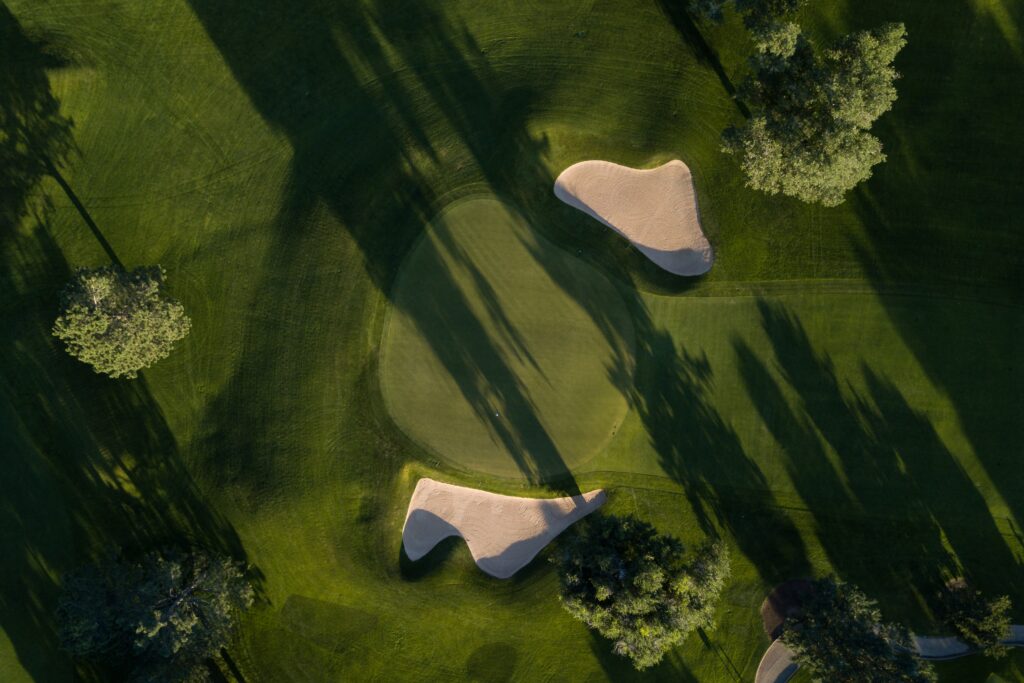
Adjustments for Draw and Fade
Hitting consistent draws or fades requires ongoing adjustments to your swing technique, equipment, and ball selection. By making these adjustments, you can fine-tune your shot shape and maximize your performance on the golf course.
Making swing adjustments
To refine your draw or fade shot, continue working on your swing path, clubface position, body alignment, and grip adjustments. Consistency is key, so take the time to practice these techniques regularly. Seek guidance from a golf professional or use video analysis tools to identify any areas that need improvement. By making small adjustments over time, you can develop a reliable and repeatable swing that consistently produces your desired draw or fade shot.
Equipment considerations
The right equipment can greatly influence your ability to hit a draw or a fade. When selecting clubs, consider the specific characteristics and design that compliment your desired shot shape. For example, certain clubheads or shaft flexes may promote a higher or lower ball flight, making it easier to achieve the desired draw or fade trajectory. Experiment with different club options and consult with a club fitting professional to find the equipment that best suits your game.
Choosing the right ball
The type of golf ball you use can also affect your ability to hit a draw or a fade. Different balls have varying spin rates and characteristics, which can influence the ball flight shape. For example, certain golf balls are designed for higher spin rates, making it easier to generate a draw. Conversely, others have lower spin rates, promoting a fade shot. Experiment with various golf ball options and find the one that aligns with your desired shot shape and performance goals.
Common Mistakes When Trying to Draw/Fade
While striving to hit a draw or a fade, golfers often fall into common pitfalls that hinder their progress. It is important to be aware of these mistakes and take steps to avoid them.
Overcompensating swing path
One common mistake golfers make when trying to hit a draw or a fade is overcompensating the swing path. When attempting to hit a draw, some players tend to swing too far inside-out, resulting in a hook. Similarly, when aiming for a fade, golfers often swing excessively outside-in, causing a slice. It is crucial to practice with a balanced swing path adjustment and gradually refine the motion to achieve the desired shot shape.
Incorrect clubface alignment
Another common mistake is incorrect clubface alignment at impact. Golfers may struggle to consistently position the clubface in the correct position, resulting in inconsistent shot shapes. It is essential to focus on aligning the clubface appropriately according to the desired shot shape before each swing. By practicing alignment drills and maintaining a disciplined setup routine, this mistake can be minimized.
Inconsistent body alignment
Inconsistent body alignment can also contribute to inconsistent shot shapes. Golfers may unintentionally shift their body alignment during the swing, affecting the swing path and clubface position. Maintaining consistent body alignment throughout the swing is key to hitting reliable draws or fades. Practice alignment drills and develop a pre-shot routine that helps you align your body consistently to the desired shot shape.
Grip pressure issues
Grip pressure is often overlooked but plays a crucial role in executing accurate draws or fades. Gripping the club too tightly can inhibit the club’s release, resulting in a less controlled shot shape. Conversely, gripping too lightly can cause instability and affect the swing path and clubhead speed. Maintaining a balanced and consistent grip pressure is essential for achieving consistent shot shapes.
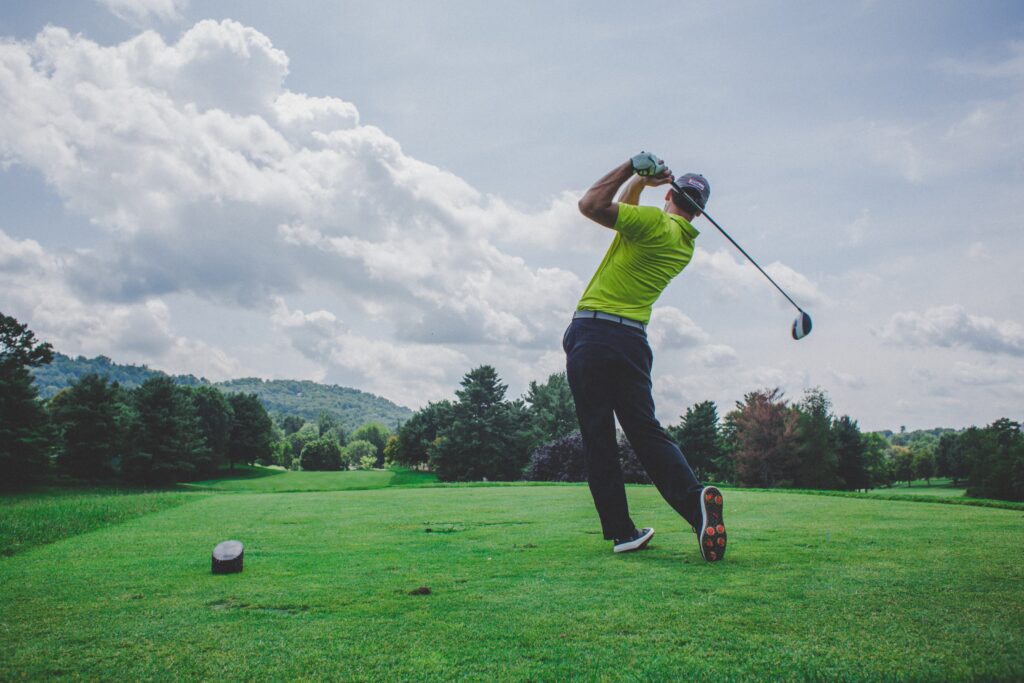
When to Use a Draw or Fade on the Golf Course
Knowing when to use a draw or a fade is an important aspect of course management. Being able to adapt your shot selection to the course conditions and obstacles can greatly enhance your performance. Here are a few scenarios where a draw or a fade can be strategically advantageous:
Using draw/fade to navigate obstacles
One of the main advantages of being able to hit a draw or a fade is the ability to navigate obstacles on the golf course. For example, if you need to carry a bunker or a water hazard, hitting a draw can help you clear the obstacle and have a shorter approach to the green. On the other hand, if there is a fairway or greenside bunker on the left side of the hole, hitting a fade can help you avoid the hazard and keep the ball in play.
Playing to course design
Understanding the course design and taking advantage of its layout can greatly improve your score. Many courses feature doglegs or tree-lined fairways that require precise shot shaping. By strategically using draws or fades, you can position your ball in the ideal spot for your next shot. Analyze the hole layout and plan your shots accordingly to maximize your scoring opportunities.
Taking advantage of wind conditions
Wind conditions can significantly influence the flight of the golf ball. By skillfully using draws or fades, you can capitalize on the wind direction and achieve better control over your shots. For example, if there is a strong crosswind blowing from left to right, hitting a fade can help you counteract the wind and keep the ball on track. Conversely, if the wind is blowing from right to left, hitting a draw can help utilize the wind to your advantage.

Mastering the ability to hit a draw or a fade is an important skill that can elevate your golf game to the next level. Understanding the differences between these shot shapes, analyzing Trackman data, and fine-tuning your techniques and adjustments will help you consistently execute the desired shot shape.
By knowing when to use a draw or a fade on the golf course, you can strategically navigate obstacles, play to the course design, and take advantage of wind conditions. With practice and dedication, you can become a more versatile and effective golfer, ready to tackle any challenge that comes your way.

